Schedule
Maize Crop Schedule
| Product Name | Fertilizers | ||||||||
|---|---|---|---|---|---|---|---|---|---|
| Poornima Kit | NPK Caps | Humigrow Nano Powder | Alp | Sonha-Bihan | |||||
| Humic Acid | Chelated Multi-micronutrient |
PGP/PGR | |||||||
| Land Reparation | week -2 | ||||||||
| Soil Treatment | week -1 | ||||||||
| Before Seed Sowing | week 0 | ||||||||
| Germination | week 1 | 1 Kit | |||||||
| Fruiting stage & Vegetative Flowering |
week 2 | ||||||||
| week 3 | |||||||||
| week 4 | |||||||||
| week 5 | 2 Caps | 120 gm | |||||||
| week 6 | 250gm | 250gm | |||||||
| week 7 | |||||||||
| week 8 | |||||||||
| week 9 | |||||||||
| week 10 | |||||||||
| week 11 | |||||||||
| week 12 | |||||||||
| Formation Flowering/ |
week 13 | ||||||||
| week 14 | |||||||||
| week 15 | |||||||||
| week 16 | |||||||||
| Harvesting | |||||||||
| Total Quantity | 1 Kit | 2 Caps | 120gm | 250gm | 250gm | ||||
| Broadcast | |
| Top Dressing | |
| Basal Dressing | |
| Soil Application | |
| Spray | |
| * | Optional |
NOTE: For the first year donot immidietaly substitute 100% chemical fertilizer with the SIESTO GREEN products, as the soil is used to chemical fertilizer, it may affect the output. So the best way to substitute is by reducing 50% of chemical input in the first year, 25% the following 2nd year, & then another 10% by the 3rd year. After the 3rd year use synthetic fertilizer / inorganic fertilizer if their is a requirement depending on the soil health.
CROP SCHEDULE FOR WHEAT
| Sr. No. | Treatment / Application | Product | Dose /Acre | APPLICATION | Management |
|---|---|---|---|---|---|
| 1 | Vegetative – Dissolve in 20 to 200 ltr. of water as required for 1 acre of land and apply through Drip Irrigation or drench. | POORNIMA KIT | 1 KIT | Apply it in week 1 | It is a balanced form of nutrients that includes NPK, Zinc, Cropforce NP, Humigrow NP, and Mycorrhiza NP |
| 2 | Vegetative – Mix all with the required amount of water and apply through drip irrigation, flood irrigation, or drenching as per farmer’s availability. | NPK + Humigrow | 2 Caps + 120gm | Apply it in week 5 | It is a balanced form of Nutrition that includes NPK. |
| 3 | Flowering – Mix both in 20 – 200 liters of water as per requirement and spray it in the plants. | ALP + Sonhabihan | 250gm + 250gm/200 lit. of water | Apply it in week 6 | It is a Micronutrient and PGP that helps in Growth, Fruit set, and the quality of the produce. |
PEST ATTACKS, BACTERIAL, OR FUNGAL MANAGEMENT
| PEST / BACTERIAL / FUNGAL | IDENTIFICATION IN CROP | SYMPTOMS | SUGGESTED PRODUCT |
|---|---|---|---|
| Stalk Rot | 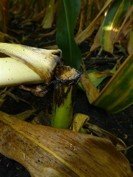 | Premature drying of lower leaves, Soft Internodes & appear tan brown from outside and pink or reddish inside. The pith is completely rotten and the stalk may lodge. | Indofa + Bacillus |
| Downy Mildew | 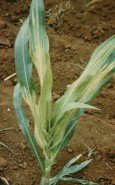 | The symptoms appear on the younger leaves. White or light green stripes appear. A white mat of fungal growth can be seen on the lower or both surfaces of leaves during wet weather. | Bacillus |
| Leaf Blight | 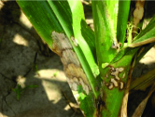 | The disease symptoms appear as boat-shaped, light grey or brown lesions on lower leaves and also on upper leaves. The cobs are small & poorly filled. | Indofa + Bacillus + Bacillus Subtilis |
| Maydis Leaf spot | 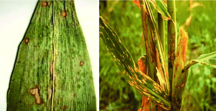 | It appears in a large number of minute to large spots of 3.75 cm long and 1.75 cm in width on leaves. The lesions are oval. These lesions coalesce and leaves may show brown-coloured stripes. | Indofa |
| Grey Leaf Spot |  | The disease is caused by Cercospora zeae-maydis. The leaf spots are brown, narrow & long which become ash grey in humid weather. | Indofa |
| Nematodes | 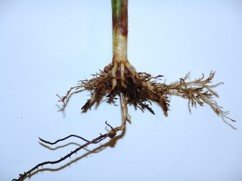 | stunting and/or yellowing of foliage and stunting, swelling, and/or browning of roots. | Meta + BT + Pacliq |
| Spotted Stem Borer |  | Larvae feed in whorls, causing small windows after the leaf grows out, and some leaves are even rolled up. The larvae tunnel into the stem and inside the stem. Larvae can also tunnel into the ears, leading to direct yield losses. | Meta + Traps + BT |
| Aphids | 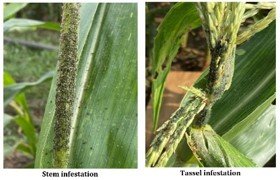 | Both nymphs and adults suck the sap from the plant, especially the leaves. This turns the leaves yellow and in the case of heavy infestation, the plants remain stunted. | Lifeline + Traps + Meta + BT |
| Pink Stem Borer | 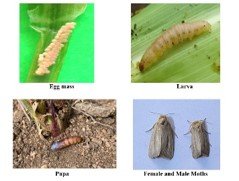 | On hatching, pink borer larvae feed in concealment inside the leaf sheath in groups and feed on the epidermal layer of the leaf sheath preferably on the first three leaf sheaths. | Meta + Traps + BT |
| Fall Armyworm | 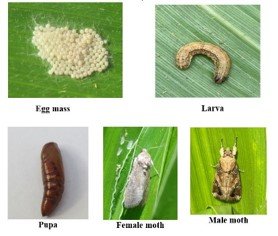 | FAW attacks all stages of maize crop from seedling emergence to ear development. The young larvae of FAW feed in and around the whorl leaves by scraping and skeletonizing the upper epidermis leaving a silvery transparent membrane resulting in papery spots. | BT |
| Termites |  | Termite invasion initiates from dry leaves. Later roots as well as the lower part of the stem are destroyed resulting in lodging. | Traps + Meta |
| Cut Worm | 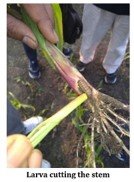 | Females lay about 300 creamy white dome-shaped eggs. The freshly hatched larva is slightly yellowish in color with a black head. The full-grown larva is greasy in appearance, plump, and dark brown in color with a redhead. | BT |
| Army Worm | 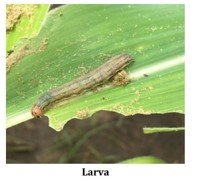 | Plants are damaged by caterpillars. Larvae feed on tender leaves and skeletonize them. In the case of a severe attack, leaves including midribs are eaten away and the fields look as if grazed by the cattle. | BT |
| Tobacco Caterpillar | 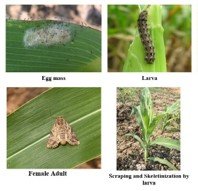 | On hatching, the larvae feed on tender leaves in groups. They scrape the surface but do not actually perforate it, creating a window pane effect. | BT + Meta |
NUTRITION DEFICIENCY IN PADDY CROP
| NUTRIENT | IDENTIFICATION | SYMPTOMS | SUGGESTED PRODUCT |
|---|---|---|---|
| Nitrogen Deficiency | 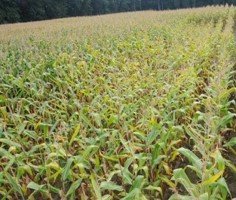 | Affected plants show spindly, sparse growth. On the older leaves, V-shaped yellowing on the leaf tips progresses towards the base, so that leaves finally turn uniformly pale green/yellow. | Azoss Caps |
| Phosphorus Deficiency | 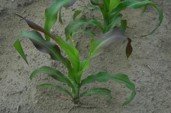 | Young plants are dwarfed and thin with dark green leaves. Leaf margins, veins, and stems show purple tints which may spread over the whole leaf blade. | PSB Plus Caps |
| Potassium Deficiency |  | The cobs of K-deficiency plants are small and peaked. Grains in the cob tips are only poorly filled. | Potash Grow Caps |
| Sulfur Deficiency | 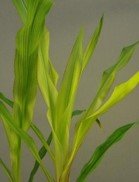 | The plant shows stunted, erect growth. Seen from a distance, younger leaves are colored uniformly pale, but when you look at them closely, it’s rather an interveinal chlorosis. | Sulphur Caps |
| Manganese Deficiency |  | Slight manganese undersupply produces hardly any visible symptoms. Severely affected plants show pale foliage with flaccid growth forms. The leaves become chlorotic with white interveinal streak lesions. | Alp |
| Zinc |  | Pale yellow chlorotic zones run parallel to the midrib starting at the base of leaves. The leaf margin, tip, and midrib remain green. | Zinc Grow Caps |
| Copper |  | The youngest leaves show yellow interveinal discoloration as they come out of the whorl. Mainly the basal part of the leaf is uniformly yellow-green. | Alp |
| Iron |  | The plant shows stunted growth. At severe deficiency, necrotic zones develop at leaf margins and tips. | Alp |
KEY FARMING POINTS
KEY FARMING POINTS
- SOIL TYPE = Well-drained Sandy Loamy Soil.
- SOIL PH = 6 to 7
- CLIMATE / TEMPERATURE = It requires a temperature of 26˚C – 30 ˚C. Rainfall of between 75cm – 150cm per annum.
- SEASON OF PLANTING = Tropical monsoon with rainy season (May-Oct) is ideal for maize planting in southeast asia .
- SPACING = Depends on farming practice, on average it is 1ft.
- MANURING & FERTILIZATION = Fertilizer requirements depend on the fertility or quality of the soil.
- WATER MANAGEMENT = Water management Maize crop is sensitive to both moisture stress and excessive moisture, hence regulating irrigation according to the requirement. Ensure optimum moisture availability during the most critical phase (45 to 65 days after sowing); otherwise, the yield will be reduced by a considerable extent.
- HARVESTING DURATION = Depends on the variety, On average harvesting starts in 45 – 60 days.
- YIELD = 2 – 6 tons (Depending on the variety and farmers’ practice, it can be increased).
- Seed Treatment kit is optional.
- Bio-pesticides or Bio-fungicides can be applied on a preventive dosage or when any pest, fungal or bacterial diseases are identified.
- Recommended dosage on this crop schedule can vary depending on soil health, environmental conditions, and pest attacks.
- 1-acre POORNIMA KIT contains: –
- NPK caps = 2 caps
- Zinc caps = 1 cap
- Cropforce Nano Powder = 120gm
- Humigrow Nano Powder = 120 gm
- Mycorrhiza nano powder = 100 gm
- Biofertilizer is not a chemical fertilizer hence do not mix with agrochemicals.
- Do not expose to direct sunlight or heat.
- Use Bio-fertilizer before or after 3-4 days of use of chemical fertilizer.
- Please, clean the sprayer before the use of Bio-fertilizer or bio-pesticide.


